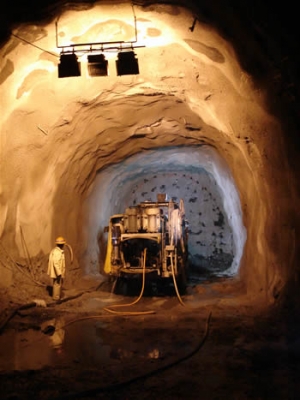Toll project to employ about 90% South Africans
Although the tender for the Open Road Tolling system project was awarded to a foreign company, more than 90% of staff on the project will be South African.
Construction sector in doldrums over delayed projects
INFRASTRUCTURE development bottlenecks are weighing heavily on SA’s construction companies.
 Construction companies are taking advantage of the surge in infrastructure spending in developing countries around the world.
Construction companies are taking advantage of the surge in infrastructure spending in developing countries around the world.
But the pace of infrastructure development in SA, despite government’s commitment to spend R845-billion in the next few years, is cause for considerable concern as major projects are being delayed, cancelled or reworked.
Not only does this affect the construction companies, but thwarts efforts to create jobs in an industry that could make a meaningful contribution to job creation and economic growth.
Construction companies, who all reported results over the past two weeks, experienced a year characterised by the loss of major multibillion-rand projects in the Middle East, delays in public-sector infrastructure investment, the postponement or cancellation of mining and other big projects, and the effects of a strong rand.
These factors affected companies to varying degrees, and strong results from companies like Basil Read and Wilson Bayly Holmes-Ovcon (WBHO) indicated that they hardly seemed to notice.
Luckily, some major construction projects had already started before the economic meltdown, including World Cup stadiums, Eskom’s build programme (although some parts have been delayed), airports and roads.
SA’s construction companies have delivered the World Cup stadiums, and continued to complete and get major projects internationally.
Their order books shrank, but have since stabilised or are picking up.
But they are all concerned about whether government will ramp up its infrastructure plans as significant portions of their project pipelines were expected to be taken up with such activity.
During the past year they already faced delays relating to Eskom’s power plant build programme, with the Kusile plant being pushed out, initially for a year, but many say it will be longer. There have also been delays and disruptions to the Gautrain and roads and transportation projects.
In the interim, they are focusing on seeking projects elsewhere to secure a strong order book and revenue stream.
This week Aveng reported a 33% drop in headline earnings for the six months to December. Revenue declined 5% to R16.8 billion, largely because its manufacturing and processing division was affected by the steel price, as well as poor results from Australasia and the Pacific regions. SA and Africa operations were strong.
Tender development expenses took a chunk out of operating profit.
It secured contracts in SA and West Africa, including at Sishen and the Sadiola gold mine in Mali.
Aveng said the rate of public sector contract awards in SA was slow, but construction spend in Australia “is underpinned by large-scale public infrastructure investments”.
Results from other construction companies were mixed. Murray & Roberts’ earnings dropped sharply, but Group Five’s earnings were 8% higher.
WBHO and Basil Read reported strong earnings growth.
Group Five said that, to mitigate the downturn in the private sector, future work would be provided locally by infrastructure investment in housing, transport, prisons, government buildings and hospitals. It said that “the timing of resumption in government infrastructure spending has been and will remain a key factor for the domestic South African construction industry”.
While there is planning for R40-billion in the public-private partnership and concessions market for large public buildings, roads and power developments, only a few awards have been made, it said.
In the Middle East, however, there were new infrastructure opportunities, including in power and heavy industries.
At Group Five’s construction business, over-border work contributed 17% to construction revenue, down from 45% the previous year, reflecting the impact of the cancellation of Middle East orders and the decline in the mining industry.
But now it is focusing “on a more aggressive over-border presence in favour of public infrastructure contracts, as well as other opportunities”.
Murray & Roberts’ order book is heavily weighted to domestic major long-term public sector projects, it said. The order book has increased by 10%, but is still 27% below the R60-billion of December 2008.
“It is the group’s view that to attract significant new private-sector investment back into the South African market, tangible evidence is required that the infrastructure backlog is being replaced and enhanced with an infrastructure surplus.”
Middle East markets, with the exception of Dubai and Bahrain, have rebounded.
Murray & Roberts said it was involved in a delay and disruption claim relating to Gautrain, brought about by late transfer of land, dolomite rectification works and funding constraints.
About R2-billion of its working capital was in domestic public sector projects, of which about R350-million was in overdue debt. In the transport and power sectors, there have been delays with current contracts, in new contract awards and with the certification of payments, it said.
Year ahead is unpredictable, says PPC
PPC expects regional demand to pick up, but more expensive fuel and electricity will affect input costs.
World Cup to boost infrastructure growth
Certain elements of infrastructure construction will pick up from the fourth quarter as the 2010 World Cup projects accelerate and near completion.
Gautrain carriages to creates jobs
The first phase of Gautrain is expected to start operating at the end of June 2010 between OR Tambo and Sandton, and it will be fully operational in March 2011.
Building industry heads for slowdown
ACTIVITY in the building industry is expected to slow significantly this year as residential and nonresidential property developers feel the strain of higher interest rates, inflation and electricity problems.
 Interest rates have gone up 4,5 percentage points since June 2006, pushing household debt costs to 11% of disposable income. This curbed consumer spending and halted a seven year rally in property prices.
Interest rates have gone up 4,5 percentage points since June 2006, pushing household debt costs to 11% of disposable income. This curbed consumer spending and halted a seven year rally in property prices.
With more interest rate hikes expected this year as the Reserve Bank battles to rein in inflation, analysts say the building industry is expected to weaken even further.
The sector has been experiencing a downturn since late last year, but the slowdown is said to be quite significant in the residential property development market.
Statistics SA figures released last week show building plans passed for the private sector in the first quarter were 1,7% down on the previous first quarter’s.
At the same time, residential building plans passed (half the total) fell 8,9% in a trend stemming from higher interest rates and lower property prices.
Wayne Basson, an industry analyst at international credit insurer Coface, said building plans passed for new houses levelled towards the end of last year, and were declining. This suggested a turn for the worse in building activity this year.
About 5%-8% fewer houses were expected to be built this year as developers felt the pinch of higher interest rates and building materials costs. The cost of materials such as cement and bricks rose as manufacturers tried to keep up with rising producer price inflation, which stood at 11,8% in March.
Cement sales, a key building indicator, peaked, and the growth rate fell sharply.
“It is anticipated that the number of residential buildings completed this year will decline 5%-8%. Even nonresidential building plans passed have declined, despite this sector expecting to show an upturn,” Basson said.
FNB industry analyst John Loos believes that the completions decline will be even higher than that.
“I believe that we may have a decline in completions in excess of 20% for 2008 in SA as a whole, which implies a significant further deterioration in the level of residential building activity,” said Loos.
He said electricity supply problems were also restricting the pace of new developments in some cases.
“On top of all of this, the global economic slowdown adds to prospects for slower economic growth, and thus job creation and residential demand in 2008,” he said.
Growth in the lower end of the housing market was, however, expected to remain robust as the government continued to spend substantially in a bid to reduce the housing backlog among the poor.
Gautrain to get extra R1bn from province
The Gautrain project will get an extra R1bn injection from the provincial government’s reserves to reduce its borrowing from R5,2bn to R4,2bn.
Focus on power crisis, with extra R60bn to Eskom
Despite rand weakness, inflation moving upwards and SA’s electricity crunch, the government will forge ahead with its infrastructure development programme
Construction industry scrambles for staff
THERE was a training crisis in the construction industry, with 88% of engineering graduates dropping out and a near halt in artisan training, a recruitment specialist said yesterday
Move to improve electricity supply
To improve efficiency and capacity, Cabinet last year agreed to restructure the local electricity industry, tasking EDI Holdings to spearhead the project.
Most Popular
Attacq and Nedbank Corporate and Investment Banking (CIB) Achieves Dual Milestone with SA’s first EDGE and Green Star Certification for Nexus commercial building
Accelerate Property Fund sells Cherry Lane Shopping Centre for R60m
FNB Broker Business Confidence declines in 1st quarter of 2024
Repo rate holds steady for 5th consecutive MPC meeting
Urbanisation drives demand for affordable housing in the Eastern Cape, TUHF

eProperty News is a leading online commercial property marketplace serving the Southern African Investment, Office, Retail and Industrial property and allied sectors.

















